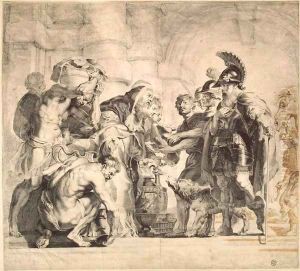Jan Witdoeck Paintings
Jan Witdoeck (sometimes spelled as Witdoek) was a Flemish Baroque engraver, born in Antwerp in 1615. His work was part of the artistic movements that characterized the region during the 17th century. Witdoeck's contributions are often associated with the prolific artistic environment that revolved around Peter Paul Rubens, one of the most influential artists of the Flemish Baroque tradition.
Witdoeck's life and career were deeply enmeshed with the city of Antwerp, which was a significant center for art and commerce during the period. He was trained in the art of engraving and developed his skills to contribute to the thriving print culture of the time. Engraving was a critical medium for reproducing and disseminating the works of artists, and Witdoeck's engravings allowed for wider access to the designs and compositions of contemporary masters.
Throughout his career, Jan Witdoeck produced engravings after designs by prominent artists, including Rubens. His works were often part of collaborative print projects, which involved multiple engravers and publishers. These projects were essential in spreading the Baroque style across Europe and making the artworks of Flemish artists accessible to a broader audience.
Jan Witdoeck's engravings are characterized by careful attention to detail and a mastery of the engraving techniques of his time. The prints he created contributed to the exchange of artistic ideas and helped cement the reputations of artists like Rubens. Despite the significance of his work in the context of Flemish Baroque art, Witdoeck's personal life details and his broader impact on art history are less well-documented than those of his more famous contemporaries.
Witdoeck continued to work in Antwerp until his death in 1684. While his name may not be as widely recognized as that of Rubens or other major figures, his engravings remain valuable examples of the printmaking practices that were integral to the art of the period. Today, his works can be found in various art collections, including museums and libraries that specialize in prints and drawings, underscoring his role in the history of European art.
